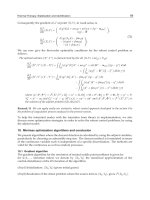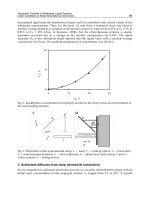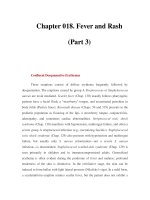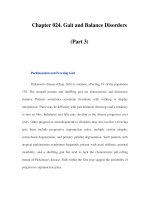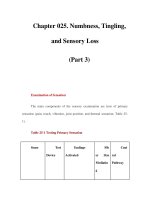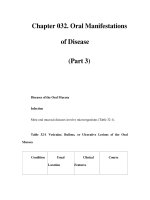Chapter 073. Enteral and Parenteral Nutrition (Part 3) potx
Bạn đang xem bản rút gọn của tài liệu. Xem và tải ngay bản đầy đủ của tài liệu tại đây (12.14 KB, 5 trang )
Chapter 073. Enteral and
Parenteral Nutrition
(Part 3)
Efficacy of SNS in Different Disease States
Efficacy studies have shown that malnourished patients undergoing major
thoracoabdominal surgery benefit from SNS. Critical illness requiring ICU care
including major burns, major trauma, severe sepsis, closed head injury, and severe
pancreatitis [positive CT scan and Acute Physiology and Chronic Health
Evaluation II (APACHE II) > 10] all benefit by early SNS, as indicated by
reduced mortality and morbidity. In critical illness, initiation of SNS within 24 h
of injury or ICU admission is associated with a ~50% reduction in mortality.
Patients with nitrogen accumulation disorders of renal and hepatic failure have a
likelihood of PCM of >50% and at least a moderate SRI. Improvements in
morbidity, including infection rates, encephalopathy, liver or renal function, and
length of hospital stay have been found with SNS. Inflammatory bowel disease—
including Crohn's disease particularly, and, to a lesser degree, ulcerative colitis—
often produce PCM. In the outpatient setting, SNS in Crohn's disease can improve
nutritional status, quality of life, and the likelihood of remission. With pulmonary
disease in the critically ill, SNS improves ventilatory status, and in acute lung
injury the use of omega 3 fats as a component of SNS improves gas exchange and
respiratory dynamics and reduces the need for mechanical ventilation. Low body
weight in chronic obstructive pulmonary disease is associated with diminished
pulmonary status and exercise capacity and higher mortality rates. However, there
is little convincing evidence that SNS as caloric supplementation improves
nutrition or pulmonary function. PCM is also common in the course of cancer and
HIV disease, although less so in the latter with the advent of highly active
antiretroviral therapy. When PCM develops as a consequence of SRI in these
conditions, there is limited likelihood of substantial efficacy or benefit from SNS.
However, when PCM develops as a consequence of gastrointestinal dysfunction,
SNS can be effective. Although no randomized trials have been performed for
SNS provided for hyperemesis gravidarum, there is considerable clinical evidence
that it improves pregnancy outcomes.
Risks and Benefits of Specialized Nutrition Support
The risks are determined primarily by patient factors such as state of
alertness, swallowing competence, the route of delivery, underlying conditions,
and the experience of the supervising clinical team. The safest and least costly
approach is to avoid SNS by close attention to oral food intake, by adding an oral
liquid supplement, or in certain chronic conditions by using medications to
stimulate appetite. Nutrient intake monitoring by frequent calorie counts or oral
formula selection is best performed by a nutritionist.
Enteral tube feeding is often required in patients with anorexia, impaired
swallowing, or bowel disease. The bowel and its associated digestive organs
derive 70% of their required nutrients directly from food in the lumen. Arginine,
glutamine, short-chain fatty acids, long-chain omega 3 fatty acids, and nucleotides
available in some specialty enteral formulas are particularly important for
maintaining immunity. Enteral feeding also supports gut function by stimulating
splanchnic blood flow, neuronal activity, IgA antibody release, and secretion of
gastrointestinal hormones that stimulate gut trophic activity. These factors support
the gut as an immunologic barrier against enteric pathogens. For these reasons,
some luminal nutrition should be provided, even when PN is required to provide
most of the nutritional support. The combination of some enteral feeding either by
mouth or by enteral tube with parenteral feeding often shortens the transition to
full enteral feeding, which can generally be used when >50% of requirements can
be met enterally. Substantial nutritional benefit can be achieved by providing
~50% of energy needs for periods of up to 10 days, if protein and other essential
nutrient requirements are met. For longer periods of time, it may be preferable to
provide 75–80% of energy needs, rather than full feeding, if this improves
gastrointestinal tolerance, glycemic control, and avoidance of excess fluid
administration.
In the past, bowel rest through PN was the cornerstone of treatment for
many severe gastrointestinal disorders. However, the value of providing even
minimal amounts of EN is now widely accepted. The development of protocols to
facilitate more widespread use of EN include initiation within 24 h of ICU
admission; aggressive use of the head-upright position; postpyloric and
nasojejunal feeding tubes; prokinetic agents; more rapid increases in feeding rates;
tolerance of higher gastric residuals; and nurse-administered algorithms. PN alone
is generally necessary only for severe gut dysfunction due to prolonged ileus,
obstruction, or severe hemorrhagic pancreatitis. In the critically ill, feeding
adequately by PN beginning within the first 24 h of care improves mortality and is
more effective than delayed EN. Early feeding of the critically ill in the ICU is
associated with a 50% reduction in mortality, but there is also a 50% increase in
infection risk. Much of the increase in morbidity related to PN and EN is due to
hyperglycemia, which can be significantly reduced by insulin therapy. The level of
glycemia necessary to accomplish this goal, whether <110 mg/dL or only <150
mg/dL, is not yet defined.
